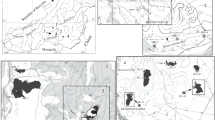Summary
The limnology of a softwater impoundment has been studied. The deep reservoir did not exhibit stable thermal stratification though biochemical stratification was quite usual. Oxygen supersaturations were rare but mostly the surface water was over 50% saturated. Oxygen deficits were noticed but they were not severe. Anoxic bottom condition was noted only once. Low alkalinity, low hardness, low chloride, calcium, silicate were characteristic of this water. nitrate was not detected, but on some days phosphates were recorded. Oxygen absorbed from permanganate was fairly high. Though chemical parameters indicate its oligotrophic nature, plankton composition gives the contrary impression. Blue-greens especiallyMicrocystis aeruginosa occurred almost round the year. Diatoms also occurred throughout the year with two exceptions. Primary production values varied but were high during diatom abundance and restricted by low nutrient levels, low carbondioxide and lower plankton numbers. Vertical and diurnal changes in alkalinity, dissolved oxygen and pH values point to a moderately eutrophic tendency.
Similar content being viewed by others
References
Brook, A. J.,Planktonic Algae as Indicators of Lake Types with Special Reference to the Desmidiaceae, Limnol. and Oceanogr.10 (3), 403–411 (1965).
Hartman, R. T., andGraffins, J. H.,Quantitative Seasonal Changes in the Phytoplankton Communities of Pymatuning Reservoir, Ecology41 (2), 333–340 (1960).
Hutchinson, G. E.,Treatise on Limnology, Vol. I, pp. 1–1019, Wiley, New York 1957.
Ray, P., andRao, N. G. S.,Density of Diatoms in Relation to Water Conditions, Indian J. Fish.11 (1), 479–484 (1964).
Ruttner, F.,Fundamentals of Limnology pp 1–244. University of Toronto Press, Toronto 1953.
Sreenivasan, A.,Limnology of Tropical Impoundments III. Limnology and Productivity of Amaravathy Reservoir (Madras State), India, Hydrobiologia26 (3/4), 501–516 (1965).
Sreenivasan, A.,Limnology of Tropical Impoundments IV. Studies of two hardwater reservoirs in Madras State, Arch. Hydrobiol.65, 205–222 (1968a).
Sreenivasan, A.,The Hydrobiological Features, Primary Production and Fisheries of Stanley Reservoir, Mettur Dam for the years 1958–68, Madras J. Fish.5, 1–17 (1968b).
Sreenivasan, A., Soundararaj, R., andFelicy, Anthony,Limnological Studies of Tropical Impoundments II Hydrological Features and Plankton of Bhavanisagar Reservoir (Madras State) for 1961–62, Proc. Ind. Acad. Sci.69, 53–70 (1964).
Welch, P. S., Limnology Mc Graw Hill, New York 1935.
Author information
Authors and Affiliations
Rights and permissions
About this article
Cite this article
Sreenivasan, A. Limnological studies on parambikulam Aliyar-project-I Aliyar Reservoir (Madras State), India. Schweiz. Z. Hydrologie 32, 405–417 (1970). https://doi.org/10.1007/BF02502556
Received:
Issue Date:
DOI: https://doi.org/10.1007/BF02502556




